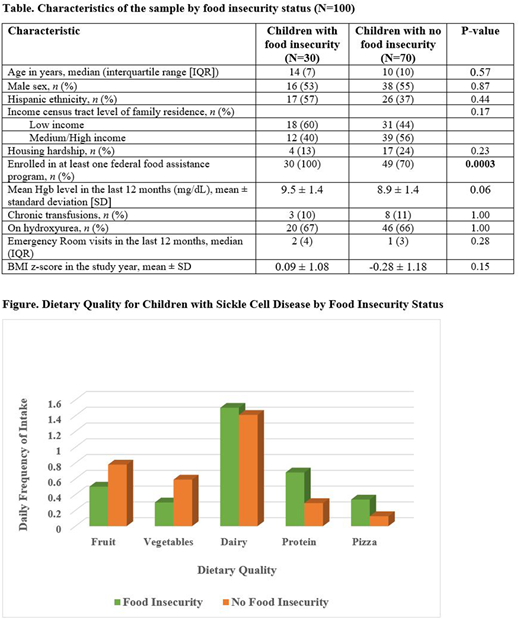Background: Understanding the effect of food insecurity on diet of children with sickle cell disease (SCD) is necessary to improve child dietary quality and optimize overall health.
Objective: To characterize the association between food insecurity and dietary quality of children with SCD.
Methods: A cross-sectional study of 100 youth aged 1-20 years with SCD and their parents was conducted from January-June 2018 at a pediatric SCD center at an academic medical center in New York City (NYC). Participating SCD patients were recruited from a convenient clinic-based sample. Food insecurity over the prior year, defined as a disruption in eating patterns due to lack of resources, was reported by adults ≥ 18 years using the validated 18-item U.S. Department of Agriculture Food Security Survey. Dietary quality in the prior 30 days was parent-reported for children <11 years and self-reported for children ≥11 years using a 15-item food frequency questionnaire adapted from the validated Dietary Screener Questionnaire (DSQ).1 Good dietary quality was defined as higher daily intake frequency of fruit, vegetable, protein and dairy and a lower frequency of pizza. Patient characteristics measured included SCD type, transfusion history, emergency room visits, housing hardship (defined as ≥2 moves in the prior year), and enrollment in federal food assistance programs (Supplemental Nutrition Assistance Program (SNAP), Special Supplemental Nutrition Program for Women, Infants, and Children (WIC), and the National School Lunch program). Multiple regression models adjusted for a priori covariates associated with food insecurity and nutrition: age, sex, and housing hardship.
Results: Of the sample, 55% were male and 50% Caribbean Hispanic (Table). Overall, 85% of children had HbSS, 13% HbSC, and 3% HbSβ0. Mean hemoglobin level was 9.0 ± 1.7 mg/dL, including 11% on chronic transfusion therapy. Participants had a median of 2.2 emergency room visits (interquartile range (IQR): 3) over the prior year. Among families, 80% lived in lower-income neighborhoods in northern Manhattan and the Bronx, 22% had housing hardship and 80% received at least one federal food assistance benefit. Among all families, 30% reported food insecurity. Children with and without food insecurity were not significantly different by age (median (IQR): 14 (7) vs. 10 (10) years, p=0.6), male sex (53% vs. 55%, p=0.9), and housing hardship (13% vs. 24%, p=0.2). Food-insecure children had significantly lower mean daily frequency of fruit (0.5 ±0.2 vs. 0.7 ±0.6, p=0.04) and vegetable intake (0.3 ±0.2 vs. 0.5 ±0.5, p=0.04) compared to those without food insecurity (Figure). Similarly, among the 80% of children receiving federal food assistance, those with food insecurity had lower mean daily frequency of vegetable intake compared to children without food insecurity (0.3 ±0.4 vs. 0.5 ±0.3 respectively, p=0.02). Food insecurity was significantly associated with increased frequency of pizza intake among all children (β=0.2 ±0.1, 95% confidence interval 0.01-0.29).
Conclusions: In this clinic-based urban sample of children with SCD, 30% experienced food insecurity and 1 in 5 experienced housing hardship. This was higher than reported NYC-wide food insecurity rate of 13% and the Bronx rate of 26% in 2018.2 Food insecurity was significantly associated with a poorer diet quality - lower mean daily frequency of fruit and vegetable intake, even among those receiving a federal food assistance benefit, and increased frequency of pizza intake. Screening for food insecurity and other health-related social needs in pediatric SCD clinic may identify many families needing assistance for basic food and housing needs, and may inform efforts to improve dietary quality and overall health in these children.
This research was conducted due to support from a NIH Loan Repayment Program for Health Disparities Research Award (NIMHD), Dr. Fernández, PI.
References:
1) Thompson FE, et al. Performance of a short tool to assess dietary intakes of fruits and vegetables, percentage energy from fat and fibre. Public Health Nutr. 2004;7(8):1097-105.
2) Gibson A, et al. The Uneaten Big Apple: Hunger's High Cost in New York City. Hunger Free America New York City Hunger Report, 2018. Available: https://www.hungerfreeamerica.org/sites/default/files/atoms/files/NYC%20and%20NYS%20Hunger%20Report%202018_0.pdf. Accessed August 2, 2020.
No relevant conflicts of interest to declare.
Author notes
Asterisk with author names denotes non-ASH members.


This feature is available to Subscribers Only
Sign In or Create an Account Close Modal